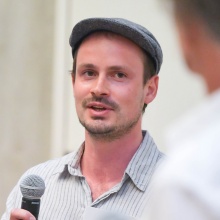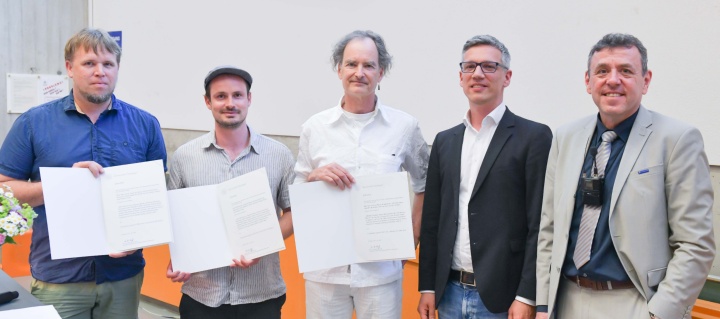For their outstanding publication
"Spatiotemporal Distribution of Precipitates and Mineral Phase Transition During
Biomineralization Affect Porosity–Permeability Relationships, Transport in Porous Media 143 (2022), pp. 527–549",
Felix Weinhardt, Jingxuan Deng, Johannes Hommel, Samaneh Vahid Dastjerdi, Robin Gerlach, Holger Steeb and Holger Class received the publication award 2022 of the University of Stuttgart for the Faculty 2.
The publication awards were ceremonially presented by the deans of the faculties on 7th June 2023 in the framework of the "Tag der Forschung".
Abstract
Enzymatically induced calcium carbonate precipitation is a promising geotechnique with the potential, for example, to seal leakage pathways in the subsurface or to stabilize soils. Precipitation of calcium carbonate in a porous medium reduces the porosity and, consequently, the permeability. With pseudo-2D microfluidic experiments, including pressure monitoring and, for visualization, optical microscopy and X-ray computed tomography, pore-space alterations were reliably related to corresponding hydraulic responses. The study comprises six experiments with two different pore structures, a simple, quasi-1D structure, and a 2D structure. Using a continuous injection strategy with either constant or step-wise reduced flow rates, we identified key mechanisms that significantly influence the relationship between porosity and permeability. In the quasi-1D structure, the location of precipitates is more relevant to the hydraulic response (pressure gradients) than the overall porosity change. In the quasi-2D structure, this is different, because flow can bypass locally clogged regions, thus leading to steadier porosity–permeability relationships. Moreover, in quasi-2D systems, during continuous injection, preferential flow paths can evolve and remain open. Classical porosity–permeability power-law relationships with constant exponents cannot adequately describe this phenomenon. We furthermore observed coexistence and transformation of different polymorphs of calcium carbonate, namely amorphous calcium carbonate, vaterite, and calcite and discuss their influence on the observed development of preferential flow paths. This has so far not been accounted for in the state-of-the-art approaches for porosity–permeability relationships during calcium carbonate precipitation in porous media.



